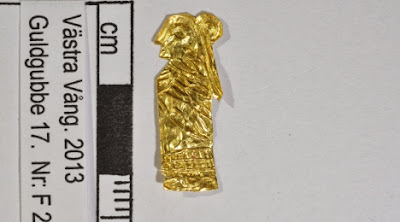 |
| Two of the anthropomorphic gold foils found at the site [Credit: Blekinge Museum] |
The initial find Henriksson refers to is his own discovery of a bronze Celtic mask back in 2004, on a hill in a valley in Vastra Vang in Blekinge. After eight years, a whole team was dispatched to the area to conduct a thorough excavation with geo-radars where the team found what Henriksson called a site "of great importance" dating back to the Iron Age, between the birth of Christ and the early Middle Ages.
The team uncovered a number of trinkets there over a period of two years, including gold foil heads of men and women that were likely used to decorate large cauldrons.
 |
| The five bronze-cast heads found at the site [Credit: Blekinge Museum] |
As to whether the artifacts were left on purpose or abandoned, Henriksson cannot say, but added that it was turbulent times when the objects were used.
"There were masses of people moving around Europe, it was right after the fall of the west Roman empire and it was every tribe for itself. It affected all of Europe. But what we can say is that the vessels we found were used for ritual drinking and feasting, and were even sacrificial. The area may have been buried or it may have been deserted and left for good. Or it could have been a ritual burial site - we're still not really sure."
 |
| View of the excavation site in the Vastra Vang valley in Blekinge [Credit: Blekinge Museum] |
"This is a unique opportunity to establish a cooperation of a kind that hasn't been possible before," Henriksson told The Local.
The artifacts will be on display in the Blekinge Museum in summer, with images of the finds to be uploaded to the website soon.





No comments:
Post a Comment